Martin Edwards's Blog, page 157
August 24, 2016
A Game of Murder - DVD Review
I've mentioned Francis Durbridge's mystery thriller A Game of Murder previously on this blog. In fact, the book was one of a trio of novels brought together in an omnibus by Bello to which I wrote the introduction a few years back. And now I've caught up with the DVD version of the original TV series, which dates back no less than half a century.
The story is divided into six short and very snappy episodes, lasting just 25 minutes each (which rather begs the question of why they are split into three discs, each containing just two episodes; wouldn't it be cheaper to bung them all on a single disc, and perhaps offer some bonus material or other notes about the TV production, features which are sadly lacking?)
Leaving this quibble aside, I must say that this was typical Durbridge affair, with an excellent, twisty plot. Gerald Harper (in his pre-Adam Adamant days) plays Bob Kerry, a rather terse young cop whose father runs a sports goods business. Their cleaner, Mrs Lincoln, is making a big fuss about her missing dog, but this pales into insignificance when Kerry's father is murdered on a golf course. At first it seems to have been a tragic accident. But Kerry becomes suspicious, and the plot rapidly thickens as the man who claims to have hit his father with a golf ball by accident is himself murdered, and the missing dog returns - but minus his collar, much to Mrs Lincoln's dismay.
Soon Kerry is embroiled in a call girl racket, and he falls for a pretty young woman (June Barry) who seems to be untrustworthy. And what about the dodgy pet shop owner (the eternally worried Peter Copley), where does he fit in to it all? One way of solving a mystery like this is to focus on the character who doesn't really seem to fit into the storyline, but in this case, there are several such individuals. I'd managed to forget whodunit, and found myself enjoying the mystery all over again. Well worth a watch.
The story is divided into six short and very snappy episodes, lasting just 25 minutes each (which rather begs the question of why they are split into three discs, each containing just two episodes; wouldn't it be cheaper to bung them all on a single disc, and perhaps offer some bonus material or other notes about the TV production, features which are sadly lacking?)
Leaving this quibble aside, I must say that this was typical Durbridge affair, with an excellent, twisty plot. Gerald Harper (in his pre-Adam Adamant days) plays Bob Kerry, a rather terse young cop whose father runs a sports goods business. Their cleaner, Mrs Lincoln, is making a big fuss about her missing dog, but this pales into insignificance when Kerry's father is murdered on a golf course. At first it seems to have been a tragic accident. But Kerry becomes suspicious, and the plot rapidly thickens as the man who claims to have hit his father with a golf ball by accident is himself murdered, and the missing dog returns - but minus his collar, much to Mrs Lincoln's dismay.
Soon Kerry is embroiled in a call girl racket, and he falls for a pretty young woman (June Barry) who seems to be untrustworthy. And what about the dodgy pet shop owner (the eternally worried Peter Copley), where does he fit in to it all? One way of solving a mystery like this is to focus on the character who doesn't really seem to fit into the storyline, but in this case, there are several such individuals. I'd managed to forget whodunit, and found myself enjoying the mystery all over again. Well worth a watch.
Published on August 24, 2016 09:06
August 23, 2016
One of Us - BBC 1 TV review
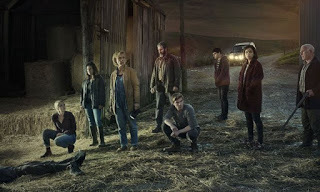
One of Us, the first episode of which aired on BBC 1 this evening, is a thriller written by Jack and Harry Williams, whose The Missing engrossed me not so long ago. And I must say right away that this one hooked me even more than that gripping tale of a boy abducted in France, and the impact of the crime on his parents.
The story got off to a dramatic start. We move very quickly from a family wedding to a murder scene - the two newlyweds have been killed. But this isn't a whodunit - we see the killer with his victims. And soon we see him again, desperate for cash, and eventually robbing a Lexus driver at knife point, stealing his car, and driving manically into the Scottish night.
These scenes are intercut with scenes featuring members of the families of the murdered couple. Dark secrets, needless to say, are soon hinted at. One character has been raped; another seems to be a possible stalker; a third is a troubled alcoholic; and so on. The killer crashes his car - and it turns out that his destination is the postcode of the homes of the two families. What is going on?
At first, the bereaved go to the aid of the grievously injured killer. But a news story on the TV alerts them to the fact that he is the murderer, although it's far from clear what his motive was (robbery, or something more complex?) They put him in a cage, one of them cancels the ambulance they had called, and the next morning, the murderer is found dead. But who killed him? Maybe it is a whodunit after all.
I really enjoyed this one. The storyline is powerful, and the cast, which includes Juliet Stevenson and Adrian Edmondson, is a strong one. I'll definitely tune in next week.
Published on August 23, 2016 15:00
August 22, 2016
St Hilda's Crime and Mystery Week-end
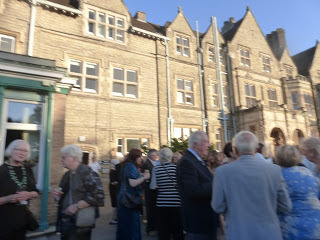
I've just returned from Oxford after taking part in the St Hilda's Crime and Mystery Week-end -the 23rd year this conference has taken place under the admirable stewardship of Eileen Roberts and Kate Charles. The company of fellow readers and writers was very convivial, as always, and the weather was kinder than the forecast had threatened. Talks were chaired by Natasha Cooper with her customary excellence, and although other commitments meant she had to leave early, Andrew Taylor was the perfect substitute to bring on from the bench.
There was a varied group of speakers, including Andrew (who discussed historical crime fiction), Marcia Talley (very good on "cozy crime") and Sarah Weinman, whose topic was domestic suspense. The international guest of honour was Lee Child, and the Friday night dinner speaker was Ted Childs, the ITV guru responsible for Inspector Morse. Val McDermid was the after dinner speaker on Saturday. I learned something from all of them.
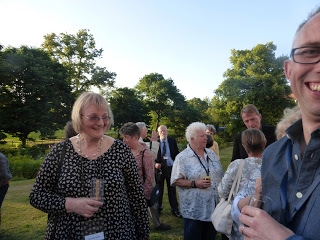
My talk was "Trending - Why is Golden Age fiction fashionable again?" I shared a platform with Carol Westron, who talked about "rules" during the Golden Age. And here let me tell a perfectly true story. I was first asked to speak at St Hilda's a long time ago; my topic was Balliol's crime writers and I was very nervous. I felt the content was okay, but (although people said nice things about the talk) I felt my delivery of the material was flawed by anxiety.. The truth is that, although I've done a lot of public speaking and advocacy in my twin careers as solicitor and writer, it's not something that has ever come naturally to me. Perhaps it's odd, but I find reading from a prepared text harder than talking without notes on a favourite topic, and making it up as I go along. But I've spoken at St Hilda's several times now, and I'm glad to say that it's become progressively easier for me. This year I worried less in advance about my presentation than I have done previously. So I've gained confidence - but it has taken a long time, perhaps longer than most members of the audience would guess.
As ever, the social side of the week-end was hugely enjoyable.. Before the conference began, I was glad to have the chance of dinner with my old friend Ann Cleeves, and on the Saturday night, those at my table included two superstars of the genre, Lee Child and Val McDermid, along with Andrew, who is one of the contemporary crime writers whom I most admire.. It was really rather memorable, and for me it was - quite genuinely - an honour to be part of it all.. .
Published on August 22, 2016 09:32
August 19, 2016
Forgotten Book - The Seat of the Scornful
My Forgotten Book today is a John Dickson Carr novel that tends to be under-estimated, perhaps because it does not offer a locked room mystery. The Seat of the Scornful (known in the US as Death Turns the Tables) was one of the first Carr books that I read in my teens; it appeared in the "Fingerprint" reprint series that also included fine books by the likes of Julian Symons and Richard Hull. Coming to it for a second time, I was again impressed.
This is a Gideon Fell novel, but in many ways the real focus is on an acquaintance of his, a tough-minded judge, Mr Justice Ireton. We see the judge in court at the start of the book, meting out his brand of justice in a manner that borders on the sadistic. Fell plays chess with him (and there's quite a bit of symbolism in the chess game) but is defeated by the judge, who is a very clever chap indeed.
The judge is a widower, with a pretty but headstrong daughter. He wants her to marry an affable barrister called Fred Barlow, but Constance has fallen for a man called Tony Morell, who appears to be a shady customer. When the judge learns that the couple are due to marry, he isn't impressed,and he soon has reason to believe that Morell is nothing more than a gold-digger.
Morell is then found dead, and the judge is at the scene, brandishing a revolver. It appears to be an open and shut case, but things quickly become complicated. This is a book where there is a good deal of focus on the subject of justice, and if I'd had more space in The Golden Age of Murder, I'd certainly have discussed it in more detail, as I think that it reflects some of the concerns about justice that preoccupied members of the Detection Club during the Golden Age. Doug Greene, the greatest Carr expert, has questioned the ethics of the final scene, and I can see why, but I found it in keeping with the mood of the times. To say more would be a spoiler. This is a really good Carr story, which deserves to be better known.
This is a Gideon Fell novel, but in many ways the real focus is on an acquaintance of his, a tough-minded judge, Mr Justice Ireton. We see the judge in court at the start of the book, meting out his brand of justice in a manner that borders on the sadistic. Fell plays chess with him (and there's quite a bit of symbolism in the chess game) but is defeated by the judge, who is a very clever chap indeed.
The judge is a widower, with a pretty but headstrong daughter. He wants her to marry an affable barrister called Fred Barlow, but Constance has fallen for a man called Tony Morell, who appears to be a shady customer. When the judge learns that the couple are due to marry, he isn't impressed,and he soon has reason to believe that Morell is nothing more than a gold-digger.
Morell is then found dead, and the judge is at the scene, brandishing a revolver. It appears to be an open and shut case, but things quickly become complicated. This is a book where there is a good deal of focus on the subject of justice, and if I'd had more space in The Golden Age of Murder, I'd certainly have discussed it in more detail, as I think that it reflects some of the concerns about justice that preoccupied members of the Detection Club during the Golden Age. Doug Greene, the greatest Carr expert, has questioned the ethics of the final scene, and I can see why, but I found it in keeping with the mood of the times. To say more would be a spoiler. This is a really good Carr story, which deserves to be better known.
Published on August 19, 2016 02:00
August 16, 2016
Following in Simenon's Footsteps
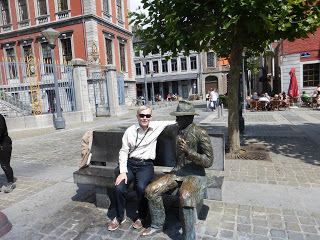
I'm just back from a short but highly enjoyable trip to Belgium, where my itinerary included a trip to Liege, birthplace of Georges Simenon, the prolific creator of Maigret and, in addition, the author of a great many notable non-series novels. There is a Simenon audio-visual tour, and the great man's statue is to be found in a square named after...Maigret. My travelling companion, Mr Edwards junior, and I enjoyed a drink in the square on a truly lovely Sunday. Sunday's also the day when the great market along the banks of the Meuse takes place in Liege, and this was well worth a visit. Other sights include an epic climb up the Mountain of Bueren, a rather steep flight of nearly 400 steps. I did get to the top, but at a stately pace...

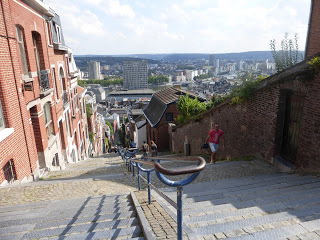
Another great trip was to Antwerp, famous for Rubens, and a port with a huge amount of character. There was plenty going on, not least the Antwerp Pride festival, and a particular highlight was a trip to the top of the MAS Museum, close to the river Scheldt, where on a sunny day the views all around are quite fantastic.


Our base was Brussels, a city I last visited a long time ago The Grand Place is as grand as ever, but this time around, there was something very special about it - the Flower Carpet, a bi-annual display of begonia petals that attracts huge crowds. It was good to be part of those crowds, as one of the locals told me that tourism in the city had been blighted by the recent terrorist attacks. Not surprisingly, there were plenty of armed police in evidence, but the mood of the city was very positive, and that was great to see.
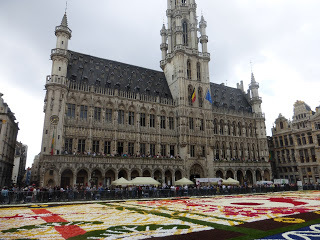
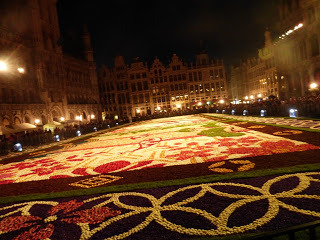

Belgium's a great country. It didn't only give us Simenon, but S.A. Steeman and Poirot as well. The landscape's flattish, but the places I've mentioned, as well as Ghent and Bruges, are truly delightful. Well worth a visit.
Published on August 16, 2016 11:15
August 15, 2016
The A-Z of Victorian Crime
The A-Z of Victorian Crime is a newly published (by Amberley) book compiled by four historians of crime - Neil R.A. Bell, Trevor N. Bond, Kate Clarke, and M.W. Oldridge. The field of Victorian crime is immense, and in their introduction, the authors explain how and why they have focused on certain subject areas rather than others. As ever with a book of this kind, it's well worth reading that intro before one starts to dip in to the detailed entries. For example, Thomas Wainewright misses out because his crimes occurred before Victoria came to the throne, though his trial took place at the start of her long reign.
I think that the overwhelming majority of readers will indeed treat this as a book to dip into, a point of first reference, rather than as a volume to be read from cover to cover at one or more sittings. I approached it in that way, and started by looking up cases with which I was familiar - examples including Christiana Edmunds and Florence Maybrick. The entries I consulted struck me as put together very competently. The challenge for the writer is always: what do I leave out? My feeling is that the approach to the necessary selectivity is perfectly sound. The same is true of the suggestions for further reading, though I felt these could usefully have been expanded somewhat without adding too much to the overall length of the book.
The real pleasure of such a book, however, in my opinion lies in chancing upon stories and pieces of information with which one was previously unfamiliar. I'd never heard of Percy Lefroy Mapleton, for example, or of Celestina Sommer or of Mary Ann Britland. Many of the entries deal with murder cases, but there are also, for instance, entries covering hangmen and police officers. Several of the entries are written with a touch of dry humour which also works pretty well.
All in all, this book makes a useful and very readable addition to the library of any true crime fan. By its nature, it offers a jumping-off point for discovery; anyone wishing to get to know the cases in depth will need to do quite a bit of further research (which is why I'd have favoured more clues about further reading). But I suspect it will also find a market among general readers who wish to know more about Victorian crime without becoming bogged down by minutiae.
I think that the overwhelming majority of readers will indeed treat this as a book to dip into, a point of first reference, rather than as a volume to be read from cover to cover at one or more sittings. I approached it in that way, and started by looking up cases with which I was familiar - examples including Christiana Edmunds and Florence Maybrick. The entries I consulted struck me as put together very competently. The challenge for the writer is always: what do I leave out? My feeling is that the approach to the necessary selectivity is perfectly sound. The same is true of the suggestions for further reading, though I felt these could usefully have been expanded somewhat without adding too much to the overall length of the book.
The real pleasure of such a book, however, in my opinion lies in chancing upon stories and pieces of information with which one was previously unfamiliar. I'd never heard of Percy Lefroy Mapleton, for example, or of Celestina Sommer or of Mary Ann Britland. Many of the entries deal with murder cases, but there are also, for instance, entries covering hangmen and police officers. Several of the entries are written with a touch of dry humour which also works pretty well.
All in all, this book makes a useful and very readable addition to the library of any true crime fan. By its nature, it offers a jumping-off point for discovery; anyone wishing to get to know the cases in depth will need to do quite a bit of further research (which is why I'd have favoured more clues about further reading). But I suspect it will also find a market among general readers who wish to know more about Victorian crime without becoming bogged down by minutiae.
Published on August 15, 2016 01:00
August 12, 2016
Forgotten Book - The Problem of the Wire Cage
The Problem of the Wire Cage by John Dickson Carr first appeared in 1939. It's a novel renowned for a tantalising "impossible crime" puzzle, tailor-made for that Chestertonian sleuth, Dr Gideon Fell. The eponymous "wire cage" is, in fact, a tennis court, with a clay surface that is surrounded by a wire fence and also poplars and a yew hedge - an ingenious variation on the classic "locked room".
Frank Dorrance is engaged to be married to Brenda White, a typically attractive Carrian heroine. Dorrance, alas,is an arrogant fellow, much less worthy than Hugh Rowland (a typically decent, yet sometimes rather irritating Carrian hero) who yearns in vain, or so it seems, for Brenda's affection. There's a financial motive for the match - Frank and Brenda are destined to inherit a fortune if they tie the knot, and Brenda's guardian, the wheelchair-bound Dr Nicholas Young, is keen to secure her long-term welfare.
Dorrance is duly found strangled, by his own scarf, in the middle of the tennis court. Heavy rainfall has left the surface muddy, and footprints to and from the body seem to incriminate Brenda. Yet surely the lovely young woman cannot have killed the man to whom she was betrothed? On the other hand, if someone else was responsible, how they did manage to murder Dorrance?
This is, first and foremost, a howdunit; guessing whodunit is much more straightforward, even though I felt the motive was not entirely convincing. The plot is ingenious, and so are the false solutions that Carr offers to tease the reader. An acrobat duly makes an appearance in the later part of the story, and a fresh line of enquiry develops before a second murder -not very satisfactorily conceived - takes place. I confess to having reservations about several aspects of this story (including the rather peripheral part played by Fell, but to say much more would be to risk giving spoilers). However, the breathtaking nature of the central murder scenario makes the book, despite those flaws, well worth reading.
Frank Dorrance is engaged to be married to Brenda White, a typically attractive Carrian heroine. Dorrance, alas,is an arrogant fellow, much less worthy than Hugh Rowland (a typically decent, yet sometimes rather irritating Carrian hero) who yearns in vain, or so it seems, for Brenda's affection. There's a financial motive for the match - Frank and Brenda are destined to inherit a fortune if they tie the knot, and Brenda's guardian, the wheelchair-bound Dr Nicholas Young, is keen to secure her long-term welfare.
Dorrance is duly found strangled, by his own scarf, in the middle of the tennis court. Heavy rainfall has left the surface muddy, and footprints to and from the body seem to incriminate Brenda. Yet surely the lovely young woman cannot have killed the man to whom she was betrothed? On the other hand, if someone else was responsible, how they did manage to murder Dorrance?
This is, first and foremost, a howdunit; guessing whodunit is much more straightforward, even though I felt the motive was not entirely convincing. The plot is ingenious, and so are the false solutions that Carr offers to tease the reader. An acrobat duly makes an appearance in the later part of the story, and a fresh line of enquiry develops before a second murder -not very satisfactorily conceived - takes place. I confess to having reservations about several aspects of this story (including the rather peripheral part played by Fell, but to say much more would be to risk giving spoilers). However, the breathtaking nature of the central murder scenario makes the book, despite those flaws, well worth reading.
Published on August 12, 2016 06:24
August 10, 2016
The Reeds - film review
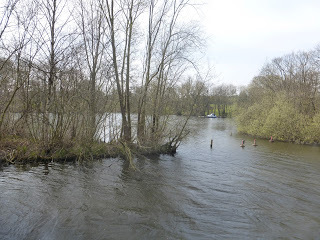
I decided to watch The Reeds, a relatively little-known horror film made in 2009, some time after undertaking a hugely enjoyable boat trip on the Norfolk Broads this spring. When I learned that a Broads boating trip was the setting for the movie, I thought it would be interesting to see how it captured the setting that entranced me. And the short answer is that the film does convey the mysterious atmosphere of the Broads, and the eponymous reeds which line the labyrinthine waterways, very well indeed.
That said, I can imagine that the tourist authorities in Norfolk will not have been keen to publicise this film, as it deals with some really rather horrid mishaps endured by half a dozen young people when they hire a boat from a grumpy old bloke called (perhaps with heavy symbolism) Mr Croker.
The six protagonists are not characterised in any depth, although one young woman has clearly had a troubled upbringing, and one of the blokes is rather too keen on looking for trouble to have much chance of survival in a story like this. The group come across a rather menacing group of youngsters, and there are some similarities in the early stages to films such as In Fear and Eden Lake.
But as the boating party gets lost in the reeds, and Very Bad Things happen with increasing frequency, it becomes evident that something else is going on. There are supernatural elements to the story, and an oddly convoluted plot, which seemed to me to lack coherence Overall, I didn't rate the screenplay highly, but the atmospheric photography of the Broads was good enough to make me glad I watched the film. But don't let The Reeds put you off taking a trip on the Broads - on a lovely day, it's a truly magical way to travel around a gorgeous part of the world.
Published on August 10, 2016 02:57
August 8, 2016
Murder in Stratford
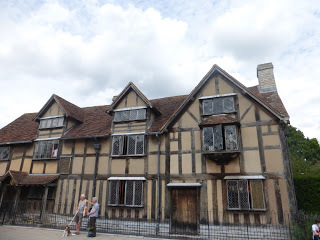
I'm just back from an unforgettable week-end at Ettington, on the outskirts of Stratford-on-Avon, taking part in a murder mystery. The occasion was a special get-together of "the Ideal Holmes Society", for one of Joy Swift's Original Murder Mystery Week-ends. And what a thoroughly enjoyable occasion it proved to be, with a large gathering of amateur detectives all trying to solve a fiendishly complicated puzzle.
I first met Joy when I was in my twenties, and she'was a young woman who had recently dreamed up the idea of creating murder mystery week-ends, which in those days took place in Southport. At that time, I was a passionate crime fiction fan with a single ambition, to become a crime writer myself, but I'd never published a word of fiction. All that was still a long way off. Anyway, I solved the mystery (and still have the certificate to prove it!) and enjoyed myself so much that I felt that if I went to another week-end it could never live up to that magical first time.
So I never went back, but I now realise that was a mistake. Joy's business has gone from strength to strength, earning her an MBE in the process. She's written well over one hundred murder mystery scripts, and they have earned a devoted following. This week-end, about 70% of those present were "returners", and some people have attended more than a couple of dozen of Joy's murder mystery week-end. The stats speak for themselves - it's really quite an addictive form of entertainment.
The scripts are very cleverly crafted, and this story was no exception. Things got off to a dramatic start on Friday evening, and twists and turns were plentiful before all was revealed just in time for Sunday lunch. One couple who had travelled from Glasgow, and who are accomplished amateur sleuths, stayed up until 3 am on Sunday morning before rising again at 6 am to figure out the last few elements of the story. They hit on the highly ingenious twist in the storyline that had eluded me; all in all, the plot was an example of satisfyingly convoluted "fair play" mystery construction in the classic vein, but with a very modern storyline, inhibited by none of the taboos of the Golden Age.
As with all the best interactive murder mystery events, there was a strong and tangible "feelgood factor" throughout the weekend. The actors did a great job; they very obviously enjoyed themselves enormously. I have resisted the temptation to publish photos of some of the highlights simply to avoid "spoilers" for those who are due to attend this event before Joy's next script comes along in a few weeks. You can certainly count me among Joy's fans, and if you ever fancy treating yourself to a week-end of murder and mystery with Joy, you won't be disappointed.
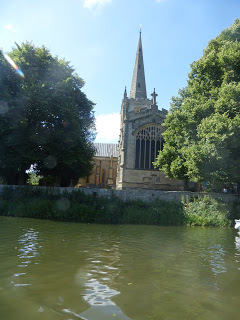
The trip also gave me the chance to go back to Stratford itself. It's often been said that, had Shakespeare been alive today, he'd have wanted to try his hand at crime fiction, and with the sun shining the tourists who flock to pay homage to the Bard were much in evidence. I had the pleasure of signing books at Waterstones on Friday and then taking a river trip along the Avon yesterday - a lovely way to end a memorable few days., .
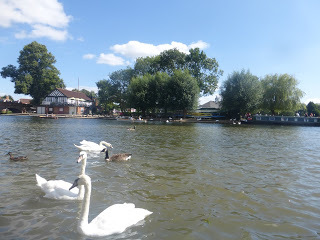
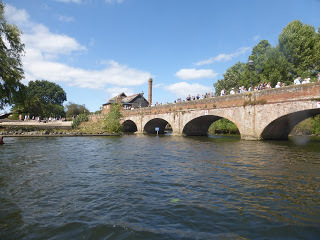
Published on August 08, 2016 03:35
August 5, 2016
Forgotten Book - Foul Play Suspected
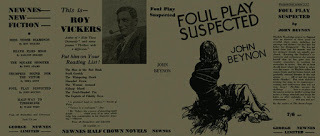
Let's pretend that you were to stumble across a signed first edition in a wrapper of an obscure 1935 novel by a debut detective story writer. How much would you expect to pay for it? Well, if the book in question was Foul Play Suspected by John Beynon, the answer would be a king's ransom. This is a rare book in any condition (an unsigned copy without a wrapper recently went for £500 on eBay) and if the author did ever sign any copies - I simply don't know if he did or not - they'd be exceptionally valuable.
Why is this? The simple answer is that the book is very hard to find, and that the author later became world famous as the science fiction novelist John Wyndham Yes, the creator of The Day of the Triffids cut his teeth on crime fiction, and this book, published by George Newnes, was followed by two others which didn't find a publisher.
The story is straightforward. Phyl comes back to England after a short and unhappy marriage has been ended by her husband's death, and discovers that her father, an absent-minded professor type of chap, has gone missing. With her cousin and a former admirer in tow, she sets about trying to find out what has happened to him. When murder is committed, Inspector Jordan comes on to the scene; he's a likeable if not especially memorable cop.
What is memorable about the book are the outspoken asides about arms manufacturers and the threat of war. This is a good example of a Golden Age mystery which casts light on the times in which it was written. The mystery itself, to be honest, is nothing special, but it's a pleasing quick, light read.
The image of the book's jacket, by the way, comes from Mark Terry's excellent Facsimile Book Jackets site.
Published on August 05, 2016 01:30



